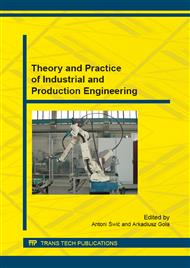p.211
p.217
p.224
p.232
p.238
p.246
p.252
p.259
p.266
Analysis of the Process of Turning of Low-Rigidity Shafts
Abstract:
A machining station, working together with a lathe, was designed and constructed for the stabilisation of the axis of low-rigidity parts in the process of machining. The basic element is a self-centring lunette with hydraulic drive, allowing part centring without any preliminary alignment. The methodology of calculation of the parameters of the “semi-finished product/supports” subsystem is given. The effect of various schematics of support arrangements on the dynamics of the semi-finished product was analysed. The analysis of schemes of low-rigidity part fixing in the device for the stabilisation of its axis was conducted with the method of initial parameters. The choice of supports and the positioning of backstays and/or buffering steady rests was also analysed for increasing the stationary character of the process of machining and the quality of shaping the machined surface.
Info:
Periodical:
Pages:
238-245
Citation:
Online since:
September 2015
Authors:
Price:
Сopyright:
© 2015 Trans Tech Publications Ltd. All Rights Reserved
Share:
Citation:


